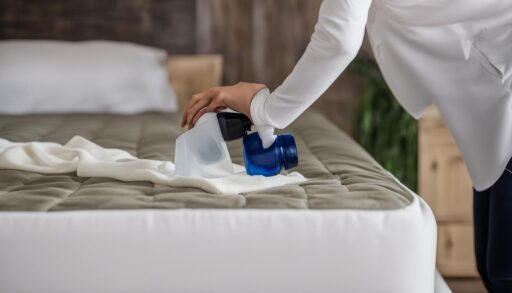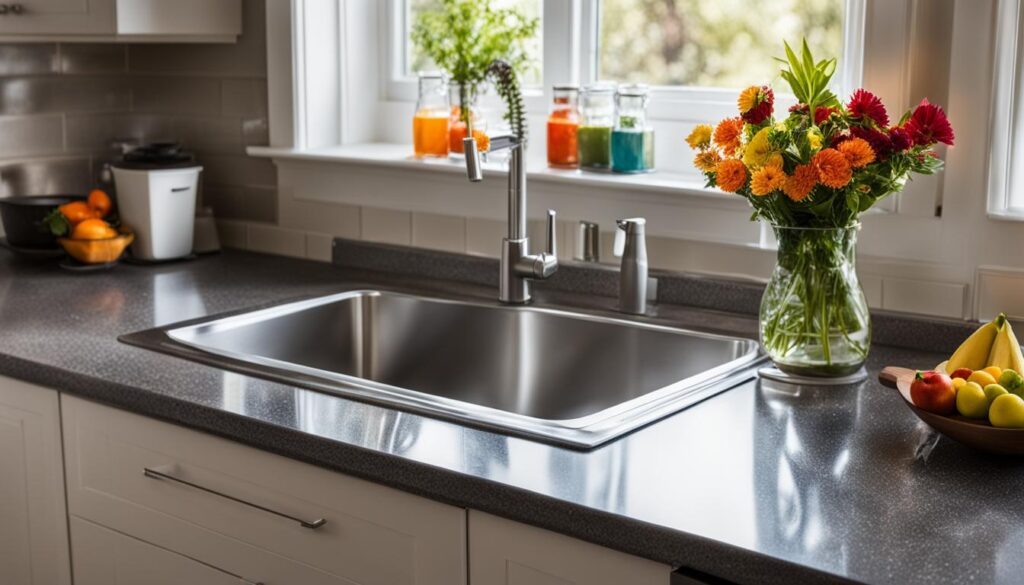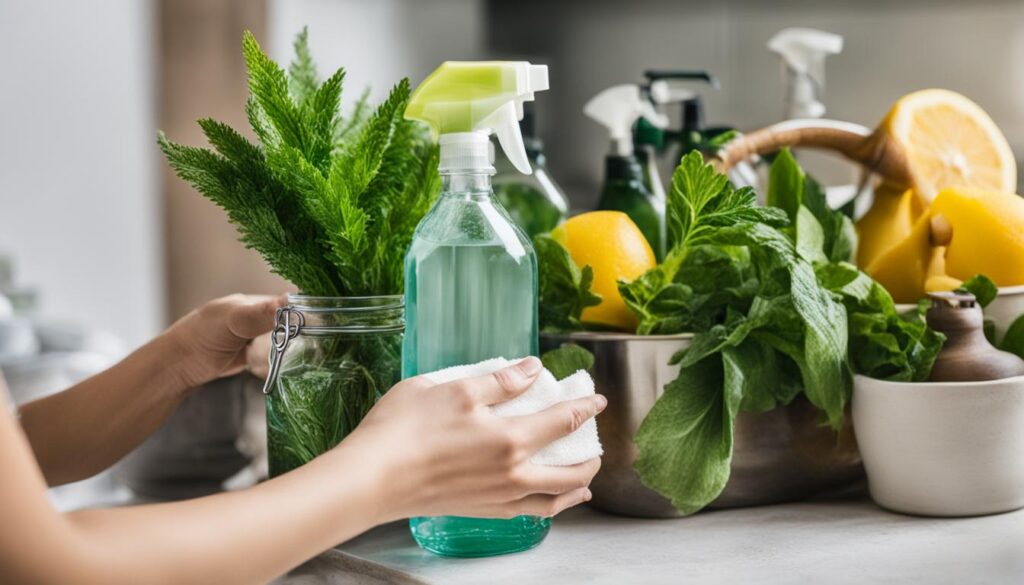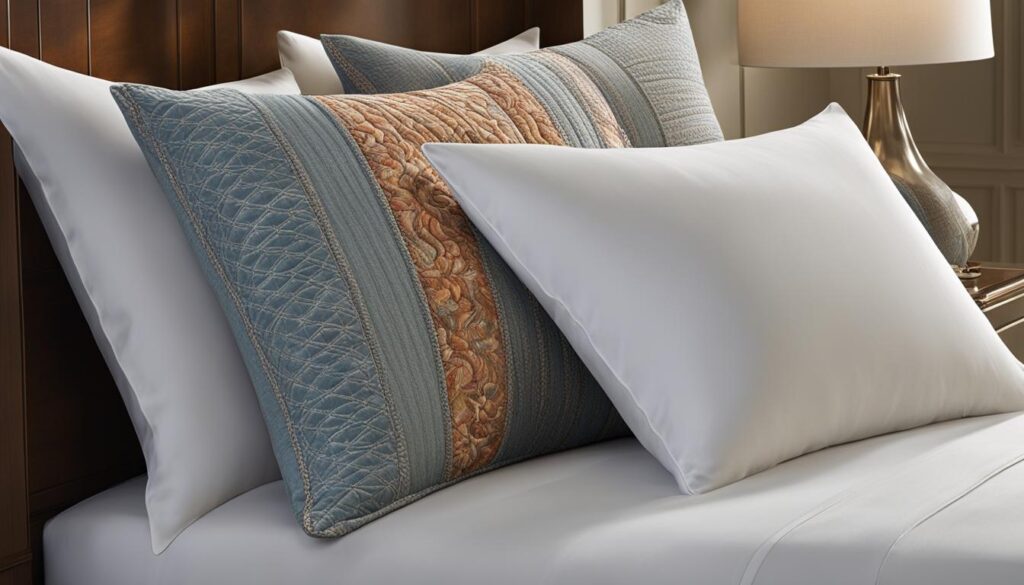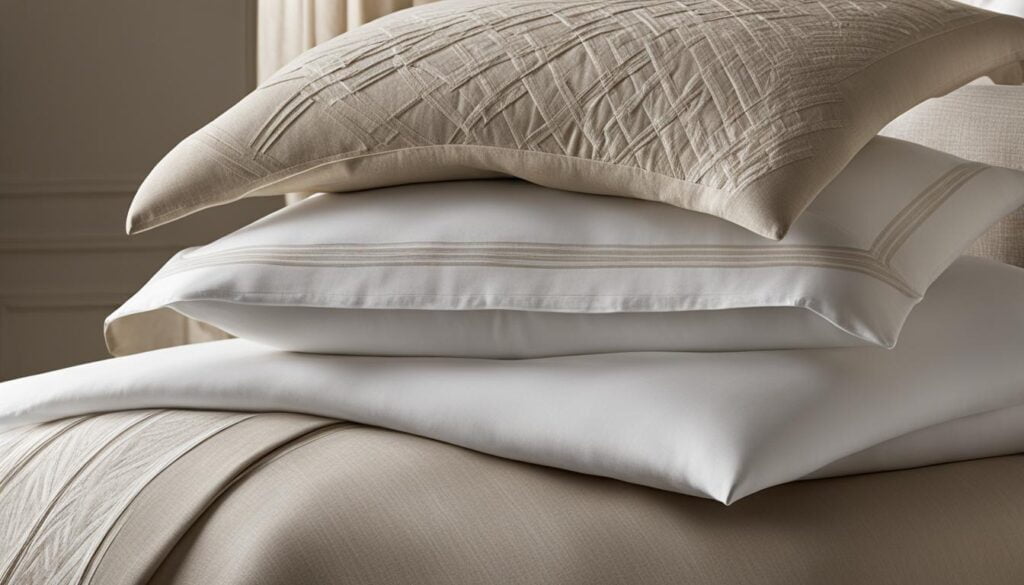Mattress Stain Removal Made Easy: Tips for a Spotless Bed
Keeping your mattress clean is essential for maintaining its longevity and ensuring a hygienic sleep environment. Stains from sweat, bodily fluids, and spills can not only be unsightly but also contribute to the growth of bacteria, allergens, and dust mites. In this easy guide, we will provide you with step-by-step instructions and helpful tips on how to effectively clean stains from your mattress.
Key Takeaways:
- Regular mattress cleaning is important for maintaining its lifespan and hygiene.
- Sweat, bodily fluids, and spills can lead to stains and the growth of bacteria, allergens, and dust mites.
- By following a cleaning routine and using natural cleaning supplies, you can effectively remove stains and keep your mattress clean.
- Cleaning your mattress regularly promotes better health, hygiene, and prolongs its comfort and support.
- Spot treating spills and stains immediately, vacuuming the mattress monthly, and deep cleaning it twice a year are recommended.
Why Should You Clean Your Mattress?
Cleaning your mattress regularly is not just about maintaining its appearance. There are several important reasons why you should prioritize mattress cleaning as part of your household routine.
1. Prolong the lifespan of your mattress: Regular cleaning helps remove dirt, dust, and debris that can accumulate over time. By keeping your mattress clean, you can prevent premature wear and tear, ultimately extending its lifespan.
2. Promote better health and hygiene: Your mattress can harbor sweat, bodily fluids, bacteria, pet dander, allergens, and dust mites. These can contribute to respiratory issues, allergies, and skin irritations. Regular cleaning helps remove these contaminants, creating a cleaner and healthier sleeping environment.
3. Improve comfort and support: A clean mattress provides better support and comfort while you sleep. Removing stains and debris helps maintain the integrity of the mattress, ensuring that it remains in optimal condition for a restful sleep.
By understanding the importance of mattress cleaning, you can make it a regular part of your cleaning routine, promoting a cleaner, healthier, and more comfortable sleep environment.
How Often Should You Clean Your Mattress?
Establishing a regular mattress cleaning routine is essential to keep your mattress free from stains, allergens, and bacteria. While you don’t need to clean your mattress as often as your sheets and bedding, it’s important to follow a few guidelines to ensure its cleanliness and longevity.
Spot Treat Spills and Stains Immediately
When accidents happen and spills or stains occur, it’s crucial to address them promptly. Using a clean cloth or paper towel, blot the spill to absorb as much liquid as possible. Avoid rubbing or scrubbing the stain, as it can spread the spill and make it more difficult to remove. Treat the stain with a gentle cleaning solution, such as a mixture of water and mild detergent or a natural stain remover, following the manufacturer’s instructions.
Vacuum the Mattress Monthly
Regular vacuuming helps remove dust, allergens, and debris that accumulate on the surface of the mattress. Use the upholstery attachment on your vacuum cleaner and thoroughly vacuum all sides of the mattress, paying attention to seams, edges, and corners. This step helps maintain the cleanliness and freshness of your mattress.
Deep Clean the Mattress Twice a Year
In addition to spot cleaning and vacuuming, it’s recommended to deep clean your mattress at least twice a year. Deep cleaning involves a thorough process that effectively removes any lingering stains, odors, and bacteria. You can either hire professional mattress cleaners or follow a DIY deep cleaning method using natural cleaning supplies. However, it’s important to check the manufacturer’s recommendations for cleaning and understand any limitations on your mattress warranty.
Summary:
To ensure a clean and hygienic sleeping environment, it’s important to establish a mattress cleaning routine. Spot treating spills and stains immediately, vacuuming the mattress monthly, and deep cleaning it twice a year are recommended practices. By following these guidelines, you can effectively maintain the cleanliness, longevity, and comfort of your mattress.
Top Natural Mattress Cleaning Supplies
When it comes to cleaning your mattress, using natural supplies is not only effective but also eco-friendly. By opting for DIY mattress stain cleaning, you can avoid exposing yourself to harsh chemicals while still achieving a fresh and clean sleeping surface. Here are some top natural mattress cleaning supplies:
- Baking Soda: This versatile ingredient is excellent for removing odors and freshening up your mattress. Simply sprinkle a generous amount of baking soda on the surface, let it sit for a few hours, and then vacuum it up.
- Essential Oils: Adding a few drops of essential oils, such as lavender or tea tree oil, to your cleaning solution can help deodorize and freshen your mattress. These oils also have antibacterial properties, promoting a healthier sleeping environment.
- White Vinegar: With its natural disinfecting properties, white vinegar is a fantastic cleaning agent for tackling stains and odors. Mix equal parts water and white vinegar in a spray bottle, and lightly mist the stained area. Blot gently with a clean cloth or sponge.
- Liquid Dish Soap: Mild liquid dish soap is effective in breaking down stains and removing dirt from your mattress. Dilute a small amount with water, and use a clean cloth to gently scrub the stained area.
- Hydrogen Peroxide: This mild bleaching agent is excellent for removing tough stains, such as blood or urine. Mix hydrogen peroxide with water and apply it directly to the stain. Blot gently with a clean cloth until the stain fades.
By using these natural cleaning supplies, you can effectively remove stains, odors, and bacteria from your mattress, ensuring a clean and healthy sleeping environment. Remember to test any cleaning solution on a small, inconspicuous area of your mattress before applying it to the entire stain.
Table: Comparison of Natural Mattress Cleaning Supplies
| Supplies | Benefits |
|---|---|
| Baking Soda | Neutralizes odors, absorbs moisture, and freshens the mattress. |
| Essential Oils | Deodorizes, adds a pleasant scent, and offers antibacterial properties. |
| White Vinegar | Disinfects, removes stains, and neutralizes odors. |
| Liquid Dish Soap | Effective in breaking down stains and removing dirt. |
| Hydrogen Peroxide | Bleaches and removes tough stains, such as blood or urine. |
Using natural mattress cleaning supplies not only ensures a clean and fresh sleeping surface but also promotes eco-friendly practices. By opting for these DIY solutions, you can maintain a healthy and hygienic mattress without exposing yourself to harsh chemicals.
How to Deep Clean a Mattress
Deep cleaning your mattress is an essential part of maintaining its freshness and prolonging its lifespan. Follow these steps to ensure a thorough and effective cleaning process:
- Step 1: Prepare the mattress. Begin by removing all bedding, including sheets, pillowcases, and mattress protectors. This will allow you to work directly on the surface of the mattress.
- Step 2: Vacuum the mattress. Use a vacuum cleaner with an upholstery attachment to thoroughly vacuum the entire surface of the mattress. This will help remove dust, dirt, and any loose debris.
- Step 3: Deodorize and disinfect. Create a solution by mixing equal parts white vinegar and water in a spray bottle. Lightly mist the entire mattress with the solution, paying extra attention to any stained areas. Vinegar has natural deodorizing and disinfecting properties that can help eliminate odors and kill bacteria.
- Step 4: Air dry the mattress. Allow the mattress to air dry completely. Place it in a well-ventilated area or near an open window on a sunny day. Ensure that both sides of the mattress are exposed to air to promote thorough drying.
Deep cleaning your mattress at least twice a year can help remove allergens, dust mites, and stains, ensuring a cleaner and healthier sleeping environment. Remember to check the manufacturer’s recommendations for cleaning and drying, as certain mattresses may require specific care instructions. By following these steps, you can maintain the freshness and longevity of your mattress.

How to Get Urine Stains Out of Your Mattress
Urine stains on your mattress can be a common problem, but with the right cleaning techniques, you can effectively remove them and restore freshness to your mattress. Whether you’re dealing with fresh urine stains or dried ones, there are natural cleaning supplies that can help eliminate the stains and odors.
Removing Fresh Urine Stains
For fresh urine stains, a simple mixture of water and white vinegar can work wonders. Mix equal parts of water and white vinegar in a spray bottle and generously spray the stained area. Let the mixture sit for about 10 minutes to penetrate the stain. Afterward, sprinkle a generous amount of baking soda over the stain and let it sit for another 10-15 minutes. Finally, vacuum up the baking soda, and the stain should be gone.
Removing Dried Urine Stains
Dried urine stains may require a more intensive cleaning process. Mix together hydrogen peroxide, baking soda, and a few drops of liquid dish soap to create a paste-like consistency. Gently apply the paste to the dried urine stain, making sure to cover the entire affected area. Allow the paste to dry completely, usually overnight. Once dry, gently scrape off the dried paste, and then vacuum the remaining residue. This method should effectively remove the dried urine stain from your mattress.
Remember, it’s important to act quickly when it comes to urine stains on your mattress. The longer the stain sits, the more challenging it may be to remove. Additionally, always test any cleaning solution on a small, inconspicuous area of your mattress before applying it to the stain to ensure it doesn’t cause any discoloration or damage.
| Materials | Instructions |
|---|---|
| Water | Mix with white vinegar for fresh urine stains |
| White vinegar | Combine with water for fresh urine stains |
| Baking soda | Sprinkle on fresh and dried urine stains |
| Hydrogen peroxide | Use for dried urine stains |
| Liquid dish soap | Mix with hydrogen peroxide for dried urine stains |
By following these methods and using natural cleaning supplies, you can effectively remove urine stains from your mattress and ensure a clean and fresh sleeping environment.
How to Remove Blood Stains from Your Mattress
Blood stains on a mattress can be unsightly and difficult to remove. Whether you’ve had a nosebleed, a small cut, or a menstrual accident, it’s essential to address the stain promptly to prevent it from setting and becoming even harder to remove. By following a few simple steps and using everyday household ingredients, you can effectively remove blood stains from your mattress.
To remove fresh blood stains, begin by creating a mixture of cold water and white vinegar. Blot the stain gently with a clean cloth soaked in the solution. Avoid rubbing the stain, as this can spread the blood further into the mattress fibers. Continue blotting until the stain begins to lift. Then, rinse the area with cold water and blot again to remove any remaining residue. Allow the mattress to air dry completely before replacing the bedding.
If the blood stain has already dried, you’ll need to take a different approach. Start by making a paste using a mixture of hydrogen peroxide, baking soda, and dish soap. Apply the paste to the dried stain, ensuring it covers the entire affected area. Let the paste sit and dry for several hours or overnight. Once dry, gently scrape off the dried paste using a clean cloth or soft brush. Vacuum the area to remove any remaining residue. If necessary, repeat the process until the stain is completely gone.
It’s important to note that before attempting any cleaning method, you should always check the care instructions provided by the mattress manufacturer. Additionally, be aware of any limitations or exclusions in your mattress warranty regarding stain removal. By taking the appropriate precautions and following these effective cleaning techniques, you can restore your mattress to its pristine condition.

How to Get Yellow Stains Out of Your Mattress
If you notice yellow stains on your mattress, don’t worry. These stains can be caused by sweat, urine, or body oils, but they can be effectively removed with the right cleaning techniques. Follow these steps to eliminate yellow stains and restore the freshness of your mattress.
Step 1: Spot Cleaning
Start by spot cleaning the yellow stains on your mattress. Mix equal parts water and white vinegar in a spray bottle and lightly spray the stained area. Let it sit for a few minutes to allow the vinegar to break down the stains. Then, using a clean cloth, gently blot the area to absorb the moisture and lift the stain. Repeat this process until the yellow stains start to fade.
Step 2: Baking Soda Application
Next, sprinkle a generous amount of baking soda over the entire surface of the mattress, focusing specifically on the areas with yellow stains. Baking soda is a natural deodorizer and will help absorb any remaining moisture and odors. Let the baking soda sit for at least 30 minutes, or overnight if possible.
Step 3: Vacuuming
After the baking soda has had time to work its magic, use a vacuum cleaner with an upholstery attachment to thoroughly remove the baking soda from the mattress. Make sure to vacuum every nook and cranny, paying extra attention to the areas with yellow stains. This will leave your mattress fresh and clean.
By following these simple steps, you can easily remove yellow stains from your mattress and enjoy a clean and comfortable sleeping surface. Regular mattress cleaning is essential for maintaining its longevity and ensuring a healthy sleep environment. Remember to check the manufacturer’s recommendations and warranty before cleaning, and consider using a mattress protector to prevent future stains.
How to Remove Sweat Stains from Your Mattress
If you’ve noticed sweat stains on your mattress, don’t worry – they can be effectively removed with the right cleaning techniques. Sweat stains not only look unsightly but can also lead to unpleasant odors and the growth of bacteria. By following these steps, you can easily get rid of sweat stains and keep your mattress clean and fresh.
To start, create a cleaning solution by mixing equal parts liquid dish soap, hydrogen peroxide, and water. Gently stir the mixture until it is well combined. Using a clean cloth, dip it into the solution and blot the sweat stains on your mattress. Be sure to work from the outside of the stain towards the center to prevent spreading the stain further.
After blotting the sweat stains, allow the cleaning solution to sit on the mattress for about 20 minutes. This will help break down the sweat and remove any lingering odor. Once the time is up, use a clean cloth to blot the area again, absorbing as much of the moisture as possible.
Next, sprinkle a generous amount of baking soda over the damp area. Baking soda is a natural deodorizer and will help absorb any remaining moisture and odor. Leave the baking soda on the mattress overnight to allow it to work its magic. In the morning, use a vacuum cleaner with an upholstery attachment to thoroughly remove the baking soda from the mattress.
By following these simple steps, you can effectively remove sweat stains from your mattress and ensure a clean and comfortable sleeping surface. Remember to clean your mattress regularly to prevent the buildup of stains and odor-causing bacteria. With proper care, your mattress will stay fresh and hygienic, providing you with a restful night’s sleep.
How to Remove Mattress Odor
If your mattress has developed an unpleasant odor, don’t worry – there are ways to eliminate it and enjoy a fresh-smelling bed again. Whether the odor is caused by sweat, spills, pet accidents, or general buildup over time, these simple methods will help you deodorize your mattress effectively.
First, start by stripping the bed of all bedding, including sheets, pillowcases, and mattress protectors. This will allow you to focus on treating the mattress itself. Next, create a natural deodorizing spray by combining equal parts water and vinegar in a spray bottle. Add a few drops of your favorite essential oil, such as lavender or eucalyptus, to mask any remaining odors and leave a pleasant scent.
Spray the mixture over the entire surface of your mattress, paying extra attention to areas where odors are more concentrated. Use a clean cloth to gently blot the mattress, absorbing the excess liquid. Then, sprinkle baking soda over the mattress, as it is known for its odor-absorbing properties. Leave the baking soda on for several hours or overnight, allowing it to absorb any remaining odors.
Finally, use a vacuum cleaner with an upholstery attachment to remove the baking soda from the mattress. Make sure to thoroughly vacuum both sides of the mattress to ensure all traces of baking soda are eliminated. Once complete, your mattress should be odor-free and ready for a restful night’s sleep.
Key Tips for Deodorizing Your Mattress
- Regularly air out your mattress by removing all bedding and opening windows to let fresh air circulate.
- Invest in a breathable mattress protector to prevent the buildup of odors and protect your mattress from spills and stains.
- Consider using a handheld steamer to effectively sanitize and deodorize your mattress.
- Rotate your mattress every few months to even out wear and tear and prevent the accumulation of odors in certain areas.
Mattress Cleaning Mistakes to Avoid
Keeping your mattress clean is important for maintaining its longevity and ensuring a healthy sleep environment. However, there are common mistakes that people make when cleaning their mattresses that can hinder their effectiveness. By avoiding these mistakes, you can ensure that your mattress stays in optimal condition for years to come.
Oversaturating the mattress with liquids: One of the most common mistakes is using too much liquid when cleaning your mattress. Excess moisture can seep into the mattress and promote the growth of mold and mildew. It’s important to use only the recommended amount of cleaning solution and to blot, not soak, the stained area.
Not allowing the mattress to dry completely: Another mistake is not allowing the mattress to dry thoroughly after cleaning. Moisture trapped in the mattress can lead to mold and mildew growth, which can cause health issues and damage the mattress. Be sure to give your mattress enough time to air dry completely before putting bedding back on.
Using harsh chemical cleaners: Harsh chemical cleaners may seem effective at removing stains and odors, but they can also damage the fabric and materials of your mattress. Additionally, these chemical fumes can be harmful to your health. Instead, opt for natural cleaning solutions that are safe and effective, such as vinegar, baking soda, and hydrogen peroxide.
Table: Common Mattress Cleaning Mistakes
| Mistake | Explanation |
|---|---|
| Oversaturating the mattress with liquids | Using too much liquid can promote mold and mildew growth |
| Not allowing the mattress to dry completely | Moisture trapped in the mattress can lead to mold and mildew |
| Using harsh chemical cleaners | Chemical cleaners can damage the fabric and harm your health |
| Not following the manufacturer’s care instructions | Each mattress has specific cleaning guidelines for optimal care |
| Not consulting the mattress warranty | Some cleaning methods may void the warranty |
| Not cleaning the mattress regularly | Regular cleaning helps prevent stains and maintain hygiene |
Not following the manufacturer’s care instructions: Each mattress has specific care instructions provided by the manufacturer. It’s crucial to read and follow these instructions to avoid damaging the mattress or voiding the warranty. These instructions may include specific cleaning solutions, methods, or restrictions.
Not consulting the mattress warranty: Before attempting any cleaning methods, it’s important to consult your mattress warranty. Some cleaning methods may void the warranty, so it’s essential to understand the limitations and requirements outlined in the warranty documentation.
Not cleaning the mattress regularly: Regular cleaning is key to preventing stains, removing allergens, and maintaining the overall hygiene of your mattress. Neglecting regular cleaning can lead to the accumulation of dust, dirt, and allergens, which can affect your sleep quality and health. Establish a cleaning routine that includes spot treating stains and regular vacuuming.
By avoiding these common mattress cleaning mistakes, you can ensure that your mattress stays clean, fresh, and comfortable for years to come. Proper cleaning and maintenance will not only extend the lifespan of your mattress but also provide you with a healthy sleep environment.
Conclusion
In conclusion, cleaning stains on your mattress is crucial for maintaining its longevity and creating a clean and healthy sleeping environment. By following the steps and using natural cleaning supplies outlined in this guide, you can effectively remove various types of stains, including urine, blood, sweat, and yellow stains. Regular mattress cleaning not only helps keep your mattress fresh but also prevents the growth of bacteria, allergens, and dust mites.
Remember to always check the manufacturer’s recommendations and warranty before cleaning your mattress, as different types of mattresses may require specific cleaning methods. Additionally, it’s important to avoid common mistakes such as oversaturating the mattress, using harsh chemicals, and neglecting regular cleaning. By taking proper care of your mattress, you can ensure its optimal condition and enjoy a comfortable and hygienic sleep surface.
Consider using mattress protectors to prevent future stains and keep your mattress in pristine condition. These protective covers act as a barrier against spills, dirt, and allergens, making it easier to maintain a clean and stain-free mattress. By implementing a regular cleaning routine and taking preventive measures, you can extend the life of your mattress and ensure a restful and healthy sleep every night.
FAQ
How often should I clean my mattress?
It is recommended to clean your mattress monthly by vacuuming it and deep cleaning it twice a year.
What natural cleaning supplies can I use to clean my mattress?
You can use baking soda, essential oils, white vinegar, liquid dish soap, hydrogen peroxide, and clean cloths to effectively clean your mattress.
How do I deep clean my mattress?
Deep cleaning your mattress involves removing and washing bedding, vacuuming the mattress, deodorizing and disinfecting with a vinegar-water solution, and allowing it to air dry completely.
How do I remove urine stains from my mattress?
For fresh urine stains, you can spray a mixture of water and white vinegar on the stain and then sprinkle baking soda and vacuum it up. For dried urine stains, a mixture of hydrogen peroxide, baking soda, and dish soap can be applied and then vacuumed.
How do I remove blood stains from my mattress?
For fresh blood stains, you can use a mixture of cold water and white vinegar to blot and remove the stain. For dry blood stains, a mixture of hydrogen peroxide, baking soda, and dish soap can be applied, left to dry, and then blotted.
How do I get yellow stains out of my mattress?
To remove yellow stains, you can use a mixture of water, white vinegar, and baking soda to treat the stain. If the stains persist, it may be time to replace your mattress.
How do I remove sweat stains from my mattress?
Mix equal parts liquid dish soap, hydrogen peroxide, and water, apply to the sweat stains, let it sit for 20 minutes, blot, sprinkle with baking soda, and vacuum it up the next day to remove sweat stains.
How do I remove mattress odor?
Adding a few drops of essential oils to a water and vinegar mixture can help deodorize your mattress. Lavender, ylang-ylang, peppermint, chamomile, tea tree, eucalyptus, and lemongrass oils are effective options.
What mattress cleaning mistakes should I avoid?
Avoid oversaturating the mattress with liquids, using harsh chemical cleaners, not allowing it to dry completely, not following the manufacturer’s care instructions, not consulting the mattress warranty, and not cleaning the mattress regularly.

